The 500cc class of the World Road Race Championships, which was competed on two-stroke machines until 2001, became a mixed two- and four-stroke competition in 2002 with the start of the new MotoGP regulation. And, as of the 2003 season, the MotoGP class has become in effect a completely four-stroke competition, thus bringing to a close the age of the two-stroke 500cc machines. Many dramas unfolded during Yamaha’s three decades of GP500 class racing, a period which saw Yamaha engineers involved in the ongoing challenge of expanding the potential of the two-stroke engine.
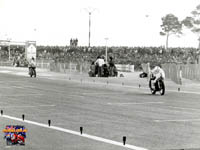
The Yamaha YZR500 factory machine won its World GP debut race back in April 1973 at the French GP, breaking the domination of the MV Agusta machines. And, after winning the manufacturers championship the following year, 1974, Yamaha continued to compete in GP racing for thirty years with its evolving YZR500 factory machines. During this period the YZR500 chalked up an enviable record of 115 wins at the hands of 20 different riders while winning a total of 11 rider championship titles and nine manufacturers titles.
The history of the YZR500 is also a history of technological innovation and evolution. In countless technologies from the YPVS born of environmental measures, the rear-exhaust system, the Deltabox frame that contributed to the machine’s outstanding handling characteristics and the electronic-control suspension to the release of technologies for the YZR500 machine itself, can be found a history of Yamaha’s philosophy of technological development. In this record of the YZR500 and its history, we look at the qualities of the successive models based on the words of the Yamaha engineers who worked on their development.
The date was April 22, 1973, and the place was the opening round of the GP series at the Paul Ricard circuit in France. For Yamaha this race marked its first GP challenge in five years and its first ever in the 500cc class. The riders who would mount the new Yamaha machine that had been developed under the OW20 code name were the previous year’s 250cc class champion on a TZ250 Yamaha prototype Jarno Saarinen of Finland and Japan’s Hideo Kanaya.
That day, Saarinen would ride the first YZR500 to victory over the 20-lap, 116.2 km course in a time of 45 min. 57 sec. to beat rival Phil Read on the MV Agusta four-stroke machine by a full 16-second margin. Kanaya followed in third place. In the second round of the series at the rainy Saltzburg circuit in Germany, Saarinen and Kanaya would finish one-two, and in doing so herald the start of a new era in GP racing.
It was the start of a new era in that the strength of the two-stroke Yamaha machine ended the domination of the four-stroke MV Agusta in the GP500 class. At the time, some 20 different makes of 500cc machines were competing in the class, including two-stroke machines from Harley-Davidson, Husqvarna, Konig, Ducati, Bultaco, Norton, BMW and Triumph, but none could stop the winning streak of the four-stroke MV Agusta.
With the exception of one win by Honda in 1966, Agusta had won the manufacturers title every year since 1958. The two-stroke models just couldn’t keep up and it was an era when there was not even a thought of the possibility of holding a round of the world championship in Japan. Nonetheless, Yamaha was working diligently on the challenge of developing the potential of the two-stroke engine.
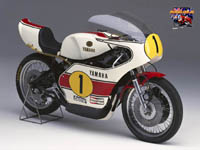 Still, the OW20 prototype was not the product of a development project aimed solely at the GP500 class. At that time, in the latter half of the 1960s, Yamaha was looking at the U.S. market as one with big potential and since 1968 had been competing in America’s biggest motorcycle race event, the Daytona 200. At that time the Yamaha race machine was based on the 350cc TR2, but as rival makers began introducing 750cc machines Yamaha began developing a liquid-cooled in-line four-cylinder 700cc two-stroke machine dubbed the YZ648 from May of 1971.
Still, the OW20 prototype was not the product of a development project aimed solely at the GP500 class. At that time, in the latter half of the 1960s, Yamaha was looking at the U.S. market as one with big potential and since 1968 had been competing in America’s biggest motorcycle race event, the Daytona 200. At that time the Yamaha race machine was based on the 350cc TR2, but as rival makers began introducing 750cc machines Yamaha began developing a liquid-cooled in-line four-cylinder 700cc two-stroke machine dubbed the YZ648 from May of 1971.
For the power unit, a “V” type engine had been an option, but taking into consideration the race competitiveness and reliability, the Yamaha engineers had decided to go with an in-line four-cylinder configuration that basically lined up two of the 350cc TR2 racer’s engines in one block. At the same time, development work was begun on the 500cc OW20 prototype that would eventually become the ’73 YZR500. Due to the regulation requiring that 700cc class machines for the Daytona race be production machines manufactured in a lot of at least 200 units, the YZ648 adopted a die-cast crank case. In contrast, the OW20 was built with a sand-cast crankcase.
Retired Yamaha engineer Takashi Matsui recalls the start of the development project: “We were intending to eventually participate in the GP500 class so we started work on a 500cc model, but at the same time we had our eyes on Daytona. So we started developing a 700cc models simultaneously, calling the 700cc the “YZ648” and the 500cc the “YZ648A.” By October of 1971 we had completed three prototypes to the point where they were running fairly well. Then we spent all of 1972 developing the finer details of the machines, which were now being referred to by their development code names “OW19” (700cc) and “OW20″ (500cc).”
A number of innovative features were developed during that year. “In order to get a much slimmer engine design, we grouped the four cylinders into units of two each and then introduced an “idle shaft” between the right and left crank shafts as the drive force shaft. The enabled an engine width about the same as a V-4. And to make the overall design even more compact, we fitted the ignition system in the space on the non-drive end of the idle shaft axis,” adds Mr. Matsui.
“From our experience developing the RD05 (the 1964 250cc GP machine) we learned that the ignition order has a big effect on the idle gear, and so we decided to use a well-balanced firing order in which the two inside cylinders and the two outside cylinders fired at the same time. In our efforts to increase the machine’s potential banking angle, we designed triangular cross-section mufflers and grouped all four exhaust pipes together and ran them under the crank cases,” recalls Mr. Matsui. These models also adopted a new chromium molybdenum steel frame with a wide-type side rail and disc brakes were added front and rear.
“At the time, we were told that the three-cylinder engines of the rival makers put out about 102 hp, while our OW20 put out 95 hp. So, the reason we were able to win our debut race was surely a result of the machine’s good overall balance rather than its acceleration,” concludes Masakazu Shiohara, head of the testing team at the time. As we see, the Yamaha development philosophy of pursuing overall performance and handling rather than depending simply on power output was already present from the first YZR500. Yamaha’s commitment to racing was also made evident the following year, 1974, when a contract was signed with Italian hero and greatest GP rider of the day, Giacomo Agostini.
The machine that Johnny Cecotto rode to victory in the Finnish GP in July of 1977 mounted a secret new device. The machine’s development name was the OW35K and it was the first YZR500 to mount what would come to be known as the Yamaha Power Valve System (YPVS). In February of the next year, 1978, when Yamaha announced its GP race program for the year, it also officially introduced its YPVS technology. The YZR500 mounting the new YPVS would be ridden that season in the 500cc class by Kenny Roberts and Cecotto, who had also been competing in the new World Championships Formula 750 class since 1977 on the YZR750 without YPVS.
At the time, the GP500 class was dominated by the Suzuki RG500, while the Formula 750 class was dominated by Yamaha bikes (three straight titles form 77-79). The YPVS technology on the new Yamaha 500cc machines quickly won attention, however, because it clearly gave them a major advantage over the rival machines in the Grand Prix.
The roots of the YPVS technology actually went back three years to know-how developed for emissions measures in 1974. Since the new device also improved performance, it was first applied in racing on Yamaha’s motocrossers and then on road racers and finally production models.
Compared to a normal four-stroke, a two-stroke only emits about 1/10th the amount of NOx, but due to the blow-by phenomenon, the two-stroke emits larger amounts of HC. Reducing these HC emissions was the development theme. Efforts to increase two-stroke power output by speeding up the exhaust timing and using the exhaust interference wave to force gas into the combustion chamber proved successful in the desired high-speed range but also resulted in an increase in blow-by gas in the low speed range, thus creating an emissions problem. It also caused a torque valley that was undesirable on a performance race machine. In order to solve this problem, a valve that enabled variable exhaust timing was added. Operating in accordance with engine rpm, this YPVS device made it possible to optimize exhaust timing at each speed range.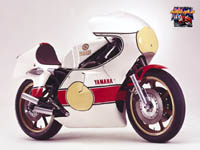
The exhaust pattern on a two-stroke engine is a cyclical one that corresponds to the combustion in the cylinders, and there are certain rpm zones where the pressure in the exhaust pipes is subject to either a cancelling out or augmentation of the pulse due to the overlapping of the successive exhausts. When negative pressure resulting from the mutual cancelling out of pulses occurs in the area of the exhaust pipe at the moment of exhaust, it increases exhaust efficiency and thus engine performance. “The history of trying to improve this unique two-stroke characteristic, called the Kadenacy effect, is virtually the history to two-stroke engine development itself. And, in the long history of Yamaha’s development of the YZR500, no single improvement has led to a bigger improvement in its lap times at the Yamaha test course than the adoption of YPVS,” says Mr. Shiohara.
Looking at the YZR500’s performance figures over the years we see that horsepower climbed from 80PS for the first model (1973) to 180PS for the 1996 model, while the maximum rpm climbed from 10,000 for the first model to 12,500 for the 2002 model. Clearly the rise in power output has been much greater than that in rpm, and the reason for this is largely the results of Yamaha engineers’ efforts to improve the “Kadenacy effect” through measures like the YPVS.
Bringing the YPVS to competition models actually involved a lot of trial and error. “The decision was made to introduce the YPVS device in GP road racing from March of 1977 and the machine chosen to mount it on was the ’77 GP machine OW35. It was given a new project code, OW35K, and work got under way. Development work had already been done for mounting the system on single-cylinder motocrossers, but this was the first time for a four-cylinder machine, and it brought a number of unique problems, like how to attach the cylinder to the crankcase and whether to make the four YPVS valves jointly operable,” says Mr. Taichi Ito, one of the engineer staff. 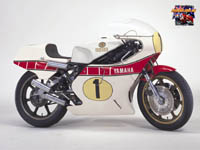
“The most common way to fasten the cylinder to the crankcase was to use stud bolts and nuts to bolt it down together with the cylinder head. However, due to the addition of the drum-shaped YPVS valves to the cylinders, a normal through-type stud bolt could not be used on the front side of the cylinder. So, at first we adopted a system where a flange was added to the front side or the cylinder for fastening, while the rear side was fastened in the usual method along with the cylinder head with stud bolts and nuts. But, the fact that the front and rear sides of the cylinders were fastened differently, thus creating imbalances in load, led to problems like cracking of the cylinders or crankcases. So, eventually we had to use a flange system on the rear side as well,” recalls Mr. Ito.
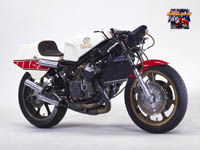 “What’s more, the addition of the YPVS valve caused greater heat distortion in the cylinders that led to problems like piston seizure, so we had to try a lot of new methods to alleviate this problem, like changing the shape to the piston cam model and the honing of the cylinder,” adds Mr. Ito. But these development efforts paid off, and eventually contributed to Roberts winning his first world title on the YZR500 in 1978. This returned the title to Yamaha after successive wins by Barry Sheene on his Suzuki in ’76 and ’77. As the YPVS continued to evolve, Roberts went on to win three successive titles.
“What’s more, the addition of the YPVS valve caused greater heat distortion in the cylinders that led to problems like piston seizure, so we had to try a lot of new methods to alleviate this problem, like changing the shape to the piston cam model and the honing of the cylinder,” adds Mr. Ito. But these development efforts paid off, and eventually contributed to Roberts winning his first world title on the YZR500 in 1978. This returned the title to Yamaha after successive wins by Barry Sheene on his Suzuki in ’76 and ’77. As the YPVS continued to evolve, Roberts went on to win three successive titles.
Today, a wide range of two-stroke powered Yamaha products from production Enduro and motocross machines to production road racers, snowmobiles and personal watercraft mount the YPVS technology. Among these, Yamaha’s Wave Runner PWCs use the YPVS as a device to boost the effectiveness of the exhaust-cleaning catalyzer by functioning to control exhaust temperature. This technological know-how would play a vital roll in the YZR500s revolution after the OW35K.
In 1981, the year after Kenny Roberts won his third consecutive world title on the YZR500, the GP became the focus of attention for new reasons. That year, Yamaha introduced a square-four model YZR500 (OW54), while Suzuki introduced the RGG500 with a square-four with a level difference between the two front and two rear cylinders. Kawasaki rolled out its KR500 and Honda entered with the four-stroke NR500. The next year, Honda finally came in with the two-stroke, three-cylinder NS500. As it turned out, the winners in ’81 and ’82 were Suzuki’s Marco Lucchinelli and Franco Uncini.
Amid these developments, Yamaha introduced its last parallel four (OW53) and its first square-four (OW54) in 1981. In 1984 came the second-generation Yamaha square-four (OW60) and its first V4 engine model, the OW61. “Through 1980 we ran with the parallel fours, but in order to match the power performance of the rival square-fours, we began development of a V4 as our next-generation racer. There was a lot of risk involved in suddenly jumping in to the races with a V4, so we first developed the same kind of square-four as the competition and fed back used the race data gained with it to the V-4 development project,” recalls Mr. Ito. What proved to be the biggest problem with the V4 design, however, was the layout of the intake system.
The square-four model OW54 introduced in 1981 adopted a rotary-disc valve that definitely delivered more power than the conventional piston-valve type parallel four. However, the added weight of the engine affected the handling stability, which led to a number of problems. Eventually, the V4 engine OW61 model was the product of development efforts aimed primarily at solving these problems by reducing engine weight and reducing its width to one comparable to a 250cc engine.
Since a two-stroke engine has a separate crankcase for each cylinder, the width of a single-axis (shaft) V4 ends up being about the same with as a parallel four. However, adopting a two-axis design enabled a design with less right-left width. It also theoretically offered the advantage of easier voluntary adjustment of the ignition angle, but the problem became where to position the intake system. In other words, the question was where on a V-4 design could you position the intake system for the rotary disc that was normally positioned on the side (lateral) surface of the cylinder.
The key that would lead to the solution of this problem came from words muttered by one of the engineers in a development staff meeting. “One day, one of our engineers was mumbling to himself, ‘If only the disc could within the “V” bank between the cylinders.’ At that minute the whole picture became clear,” recalls Mr. Shiohara. This gave birth to a highly original concept of throwing out the side-mounted rotary disc with its inherently limited forward projection area, positioning the carburettors in the “V” of the block and having one rotary disc service two cylinders. Now the race was on to test a prototype and get it ready for use in actual competition. This led to the birth of the rear-surface rotary-disc valve intake system. 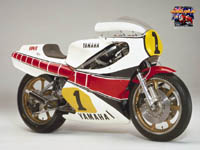
“In the early stages of development we had problems like the fact that the drive portion of the disc began to wear very quickly and that we were unable to exceed the performance of a conventional rotary disc. But, believing in its future potential, we continued to improve on it through trial and error until it gradually matured as a system. Still, I never imagined that the V4 format we were creating would become the standard engine format for the next 20 years, says Mr. Shiohara.
This OW61, the first YZR500 to mount a V4 engine was unveiled at Saltzburg in May of 1982. Then, two years later the OW76 appeared with a crankcase reed valve. Eddie Lawson rode this machine to win his first world title in 1984, after which the V4 engine continued to dominate the GP scene.
The biggest turning point for the two-crank-axis V4 probably came with the OW81 in 1985, ’86. This was the machine that Lawson won back his title on after losing it to Freddie Spencer on the Honda NSR500 in ’85. “On the OW76, the first YZR500 to adopt a crankcase reed valve, there were things we still had to work out concerning the effect of the engine characteristics on the machine handling. We needed to improve the gyro moment of the crank shafts, find measures to improve torque reaction and reduce vibration,” says Mr. Shiohara. These things caused the development team to turn its attention to the revolving direction of the crankshafts.
With the existing two-crank V4, both crankshafts revolved in the direction of forward motion, but the question was raised that that might be affecting the handling stability of the machine. A prototype was created to test this possibility. “In fact, we had created the OW77 prototype and were already running tests on it since the previous spring. It had a two-crank V4 engine on which both crankshafts could be revolved in either direction and it was set up to enable actual running tests as well. Based on those running tests it was decided to have the two cranks revolve in opposite directions, and we built that into the layout.” Mr. Shiohara adds.
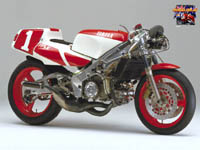 Eventually, the structure adopted on the OW81 had the two crankshafts revolving in opposite directions (the forward shaft opposite to the direction of forward motion and the rear in the direction of forward motion) with the drive force picked up from the rear shaft. This layout reduced the gyro moment effect on handling stability to a minimum to help make the YZR500 a machine with excellent handling characteristics.
Eventually, the structure adopted on the OW81 had the two crankshafts revolving in opposite directions (the forward shaft opposite to the direction of forward motion and the rear in the direction of forward motion) with the drive force picked up from the rear shaft. This layout reduced the gyro moment effect on handling stability to a minimum to help make the YZR500 a machine with excellent handling characteristics.
This would not be the only engine development effort aimed at improving handling stability. On the 1992 model OWE0, simultaneous phase combustion was adopted from the latter half of the season. “This 0-degree / 90-degree simultaneous phase combustion improved the rear traction characteristics and thus boosted acceleration performance coming out of the curves. On the other hand, however, there were some problems that would never be expected with 180-degree simultaneous combustion. Combustion force caused increased stress to the gearbox assembly and the clutch assembly and also led to fears about the reliability of the gear assembly. Of course we couldn’t send a machine we had fears about into the GP, so we cancelled our summer vacations and ran repeated endurance tests until we had the durability demanded,” recalls Mr. Hiroya Atsumi, an engineer staff of the OW81 at the time.
“We were eventually able to introduce this machine from the second half of the GP series that year, and we stuck to our firm belief that the first step of handling stability was having a machine that the riders could use with full confidence in its reliability. In another aside, we continued tests with different ignition timings, including a 70-degree / 290-degree interval. Among our riders, Luca Cadalora and Kevin Magee especially liked this spec. But, in the long run we eventually settled on the 0-degree / 90-degree spec. This was because of the good torque balance it provided between the combustion torque and the inertial torque produced by the revolution of the crankshafts,” adds Mr. Atsumi.
The development of the two-crankshaft V4 model, which began with the trial-and-error search for the right intake system, would proceed to a history of crankcase reed valve development introducing high-performance resin plastics, as well as a pursuit of handling stability and the kind of reliability that lets the rider ride with assurance. This is the foundation that the YZR500 was built on and it is the starting point for any motorcycle. It is Yamaha’s starting point.
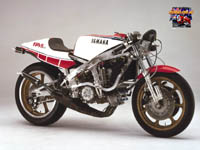 The history of the YZR500 is also a history of suspension development. After winning the first two rounds of its debut season in 1973, Jarno Saarinen was again in the lead with the fastest lap time in the third round at Hockenheim in West Germany when his chain broke and he was forced to retire from the race. The winner that day was Phil Read on his MV Agusta. In the fourth round at Monza, Italy, Saarinen was the victim of a fatal crash caused by another machine’s oil leak in the 250cc race. In honour of Saarinen’s memory, Yamaha withdrew from GP competition that year.
The history of the YZR500 is also a history of suspension development. After winning the first two rounds of its debut season in 1973, Jarno Saarinen was again in the lead with the fastest lap time in the third round at Hockenheim in West Germany when his chain broke and he was forced to retire from the race. The winner that day was Phil Read on his MV Agusta. In the fourth round at Monza, Italy, Saarinen was the victim of a fatal crash caused by another machine’s oil leak in the 250cc race. In honour of Saarinen’s memory, Yamaha withdrew from GP competition that year.
During this period, development continued. And, the following year, 1974, the YZR500 returned to the GP in its OW20 spec with the new Monocross suspension that significantly improved the machine’s competitiveness. To ride the OW20, Yamaha signed a contract with former MV Agusta star Giacomo Agostini, who teamed with Tevo Lansivuori. That year, Agostini won round three at Salzburg and round six, the Dutch GP, while Lansivuori won round eight at Anderstorp. This record brought Yamaha its first manufacturers championship title in the 500cc class for 1974.
The secret behind this new world-beating performance was the Monocross suspension. This suspension was characterised by the fact that its positioning of the shock absorber under the fuel tank enabled a larger wheel stroke than a conventional suspension. The basic structure of this suspension was patented by a Belgian professor. Yamaha acquired the rights to the structure and proceeded with research and development and applied it to its motocross factory machines on a trial basis. It was unveiled for the first time on the YZM125/250 machines Yamaha entered in round one of the All Japan Motorcross Championships series at Yatabe. The following year, 1974, it was also adopted on the OW20 that would win the manufacturers championship title along with Agostini’s rider title that year.
Of course the same motocross-use suspension was not simply transplanted as it was to the road racer. “On the OW20, the accumulator had the same basic ball structure as that on the motocross machines, but we need to make significant changes in the settings, adjust the overall length by introducing an adaptor and fine-tune the damping force adjustment mechanism for the compression stroke. On the OW20, the monocross suspension provided increased cushioning performance and a better concentration of mass at the centre of gravity that contributed to improved handing stability,” says Mr. Makoto Sugimoto, who was in charge of performance testing.
Furthermore, the Monocross suspension adopted on the OW23 spec the following year featured a new accumulator design that contributed to more stable hydraulic fluid pressure, as well as improvements including revised settings, new aluminium and magnesium parts to reduce unit weight and a screw-type initial load adjustment mechanism for the spring. In these ways, the suspension was improved year by year and became an important asset contributing to Kenny Roberts’ three consecutive GP titles. And, the improvements would go on in the years to come as the YZR500 continued to evolve.
The early ’80s saw another big development in the suspension. It came with the introduction of the second-generation YZR500 with a square-four engine, the OW60 of 1982. The OW60, which won its debut race in the opening round of the GP series, was a full six kg lighter than the OW54 of the previous year. At the same time, this spec adopted successful new suspension technologies that included the use of a “bell crank” that produced progressive effect to move the shock absorber.
“With the introduction of the Monocross suspension Yamaha had gained a definite advantage over the competition. But the competitors then came back with link-type suspensions that developed the possibilities of a rising-rate effect. In response, Yamaha began testing a rising-rate approach with the OW53 only to find that adding a link mechanism to the existing shock unit was not enough to render a significant effect. With the OW60, Yamaha stuck to the basic structure that identified the “Monocross suspension” with its shock positioned under the fuel tank and added a bell crank to move the shock absorber. Also a lighter unit was developed for the shock absorber itself,” comments Mr. Shigeto Kitagawa, one of the engineer staff of this project. In this way the OW60 became the groundbreaker for the next development of the Monocross suspension.
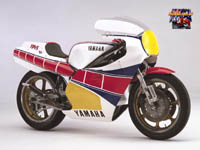 The excitement of the one-two finish by Kenny Roberts and Barry Sheene on the bell crank-fitted OW60 at the season opener in Argentina on March 28 had barely time to subside before Yamaha called a press briefing on the paddock at round two of the series at Saltzburg on May 2 to introduce a new factory machine the OW61. This OW61 was the first YZR500 to mount a V4 engine and it also feature a new aluminium frame that eliminated the under-loop. This frame structure would be the roots of the coming Deltabox frame, and here again an innovative suspension was introduced. In it, the shock absorber was positioned at right angles to the direction of forward motion with links at both ends in a layout that would come to be called the “crab claw.” This design featured excellent space efficiency while contributing to a lower centre of gravity.
The excitement of the one-two finish by Kenny Roberts and Barry Sheene on the bell crank-fitted OW60 at the season opener in Argentina on March 28 had barely time to subside before Yamaha called a press briefing on the paddock at round two of the series at Saltzburg on May 2 to introduce a new factory machine the OW61. This OW61 was the first YZR500 to mount a V4 engine and it also feature a new aluminium frame that eliminated the under-loop. This frame structure would be the roots of the coming Deltabox frame, and here again an innovative suspension was introduced. In it, the shock absorber was positioned at right angles to the direction of forward motion with links at both ends in a layout that would come to be called the “crab claw.” This design featured excellent space efficiency while contributing to a lower centre of gravity.
In its debut race, Roberts rode the OW61 to a third-place finish, and then to victory at the Spanish GP. But the goddess of victory smiled no more on the lateral suspension OW61. Eventually, this would be the last machine to use this suspension, but it would be remembered as an example of the kind of taboo-breaking, free thinking design that lies at the heart of Yamaha machine development.
“A lot of research went into the lateral suspension from a number of directions. We gathered data about how much contract the tire had with the road surface during cornering, acceleration and over bumps. Then we would take that data to the test lab and use it in analysis utilizing a servo pulser. The results we got in the lab would then be taken back to the GP circuit and new things tried to improve the system. But we also realized that the space interference resulting from the lateral layout of this suspension was preventing us from making optimum use of the thinner engine made possible by the rear-surface rotary-disc valve system. Also, we found that the reaction force from the road surface produced undesired flexing in the shock absorber itself in the case of a lateral suspension. We finally reached the conclusion that a vertically positioned shock absorber placed less additional load on the shaft, and after that we decided to concentrate our development efforts on a vertical shock layout,” says Mr. Takaaki Suzuki, who was in charge of tests.
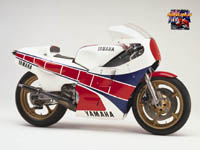 For the next model, the OW70, the design was returned to the bell-crank type suspension used on the OW60. “All the new things we tried with the lateral suspension brought with them an element of uncertainty. We could have chosen to keep working on the detail until we got a mature system, but we knew there would be considerable difficulties involved, so we decided to return to the proven bell-crank format for the rear suspension. At the same time, we were working on the chassis development with the focus on keeping the basic framework of the frame within the same width as the V4 engine. This effort would lead to the birth of the aluminium Deltabox frame,” explains Mr. Sugimoto.
For the next model, the OW70, the design was returned to the bell-crank type suspension used on the OW60. “All the new things we tried with the lateral suspension brought with them an element of uncertainty. We could have chosen to keep working on the detail until we got a mature system, but we knew there would be considerable difficulties involved, so we decided to return to the proven bell-crank format for the rear suspension. At the same time, we were working on the chassis development with the focus on keeping the basic framework of the frame within the same width as the V4 engine. This effort would lead to the birth of the aluminium Deltabox frame,” explains Mr. Sugimoto.
As it turned out, the OW70 introduced for the ’83 GP season mounted a bell crank format suspension, but by mid-season the OW70 would be given a bottom-link type suspension that further improved performance. This machine, with the new bottom-link suspension would be the one Kenny Roberts rode against Spencer on the three-cylinder Honda in one of the closest title bouts in GP history. The OW76 spec introduced from the start of the 1984 GP season mounted another bottom-link suspension with the same basic structure that GP machines use to this day, though with each year’s GP this suspension has continued to be improved and matured.
This was a period that saw the appearance of the Monocross suspension and its development into the bottom-link type suspension. This development coincided with the change from the square-four to the V4 engine, the adoption of the crankcase reed valve and also the appearance of the first Deltabox frame. Never before had the YZR500 gone through so many dramatic changes in such a short period of time.
The aluminium Deltabox frame first introduced in 1983 on the OW70 became a defining feature of the YZR500 in the years that followed. This OW70 was the machine Kenny Roberts rode in his legendary GP battles with Freddie Spencer on the three-cylinder Honda NS500. Externally the machine was characterised by the three connecting points of the chassis’ triangular framework, two points at the top and bottom of the steering head and one at the pivot. The aim of this design was increased handling stability and manoeuvrability.
However, the original aim of the Deltabox configuration was not simply increased frame rigidity. It was born of the quest and research for a frame on which the new V4 engine could be mounted most efficiently.
“On the OW61, the first spec to mount the V4 engine, it was necessary to fit the carburettors and the rotary-disc valves neatly inside the “V” bank of the engine block. This led to the proposal to adopt an aluminium frame on the OW61 that would offer good engine mounting and efficient space allotment for the intake system,” says Mr. Sugimoto.
It was the following OW70, however, that was first to use the frame that is now called the Deltabox. As we mentioned with regard to the suspension development, the lateral suspension adopted on the OW61 prevented the adoption of a slimmer frame that would have been possible with the narrow engine format achieved with the rear-surface rotary disc valve V4. “It was on the OW70 of 1983 that we dealt with this issue by working to develop a frame that was roughly the same width as the engine while also being lightweight and highly rigid. The answer we came up with was the Deltabox frame.”
Some unique ideas were tried in the process. “At first we thought of using the interior of the main frame for the fuel tank in order to achieve a greater concentration of mass at the centre of gravity. We tried using a special coating used in aircraft on the inside of the frame sections, but eventually there were regulation-related problems that prevented the use of the in-frame tank in actual GP racing. The Deltabox frame that eventually appeared in GP competition on the OW70 was a product of further refining the combination of pressed parts and machine cutting parts used in the OW61 frame and then employing computer analysis to achieve a high degree of lightness and slimness.”























